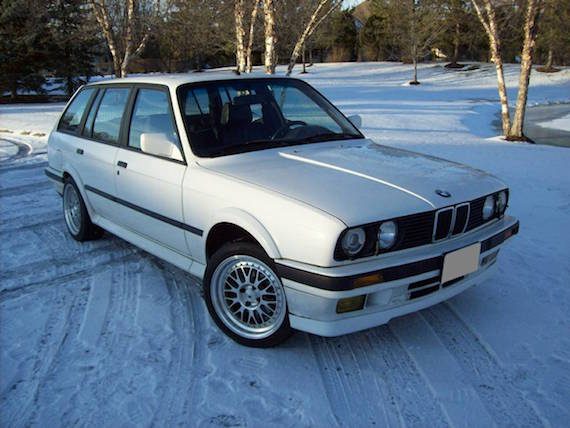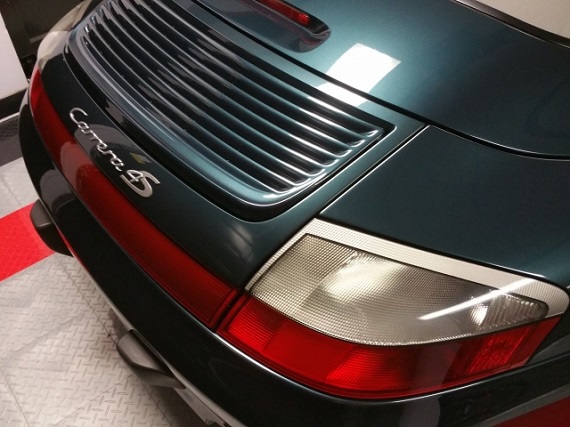Few Porsches capture the imagination and turn heads like the 911 GT2. And among the various iterations of the GT2, the 993 GT2 is the most coveted. While engineering and technological progress naturally have rendered later models more powerful and sophisticated performers, the raw prowess of the original car remains the benchmark. Serving as both the first 911 GT2 put into production as well as the last and only air-cooled GT2 produced, the 993 brings with it the kind of rarity that rapidly elevates prices. Add in that it represented the highest performance among production 911s of its day and you’ve pretty much checked all of the boxes a collector could desire. The example we see here, a Speed Yellow 1996 Porsche 911 GT2 having traveled around 33K kilometers during its life, will be up for auction next Friday at RM Sotheby’s auctions in Phoenix.
Year: 2017
Audi’s naming convention between 1985 and 1995 was, to say the least, a bit confusing. Audi had already changed its B2 series to the 4000 designation and C2/3 series to 5000 to help differentiate them from the earlier models. Starting in 1986, Audi introduced the “CS” designation. In the 5000 model, that denoted the turbocharged model, as the “S” was lower spec model. The same carried to the 4000 model. In both cases, the “S” model was no longer available with quattro. This was a bit confusing, as the 4000S quattro had been available in ’84/’85, and the ’86 model was effectively identical to the outgoing ’85. It was more confusing, though, in ’87, when the “S” model was introduced with quattro in the 5000 range but not in the 4000.
In 1988, the trim levels changed again. Now the 4000 designation was gone, replaced with the B3 models that brought the small sedans in line with their European counterparts. Now there was a low spec 80 and a high spec 90, both available with quattro. The 5000 soldiered on for another year with only revised badging script to bring it in line with the change.
In ’89, the 5000 was changed over to match the 80/90 with the 100/200 models. As with 80/90, the 100/200 differentiated trim and engine choice. Quattro was available in both models, but the 200s were higher spec and had turbochargers. It made sense.
Things started to get confusing again in 1992, though. Audi was really struggling to make sales in the U.S., and the introduction of the new “S” performance models further muddied the waters as the new C4 was introduced. Gone was the 200, but S/CS designation was back! However, since turbocharged models were limited to the S4 in the U.S., there was no 100S quattro – only the 100CS quattro. This convention, however, only lasted 3 years.
At the same time, the 90 range was also revised in 1993 to the new B4 model. In 1992, only the 80 model was available, but when the new 90 model was launched, the 80 was gone and the 90 was now S/CS trim, too. The strange changes continued in 1995, when thoroughly frustrated by their lack of sales success Audi completely relaunched their brand with the new “A” series of names. So, in 1995, the 100 became the A6 and the S4 became the S6, with only minor changes between the two. But the 90 continued alongside the A6 range for one more year until the new A4 was ready, although the CS was dropped in that year and replaced with “Sport”. Still with me?
The point of all this is that each of these generations of Audis is pretty unique, but none were particularly sales successes. In the case of the 100CS quattro we see here, a scant 5,000 of which were sold in the U.S.:
CLICK FOR DETAILS: 1994 Audi 100CS quattro on eBay
2 Comments It’s been a balmy couple of days in DC, with temperatures shooting up to around 60 degrees. One could be forgiven for wondering where the winter went. It will soon be here, I’m sure. And with it the snow and ice, the city-wide shutdown, and the terrible drivers causing pile-ups around the beltway. What would be the ideal winter warrior for times like these? The E30 325iX quickly comes to mind. A brief search on Craigslist throws up a number of tidy options (as well as the usual plethora of over-priced rust buckets). But one in particular stands out, a bit of a unicorn. AWD? Check. Manual? Check? Wagon? Check! Eye-watering price? Double check!
It’s been a balmy couple of days in DC, with temperatures shooting up to around 60 degrees. One could be forgiven for wondering where the winter went. It will soon be here, I’m sure. And with it the snow and ice, the city-wide shutdown, and the terrible drivers causing pile-ups around the beltway. What would be the ideal winter warrior for times like these? The E30 325iX quickly comes to mind. A brief search on Craigslist throws up a number of tidy options (as well as the usual plethora of over-priced rust buckets). But one in particular stands out, a bit of a unicorn. AWD? Check. Manual? Check? Wagon? Check! Eye-watering price? Double check!
CLICK FOR DETAILS: 1989 BMW 325iX Touring on Columbus, OH Craigslist
6 CommentsThis will be a rare feature for us, but like with most 911s I’m always curious to see colors and color combinations that I don’t come across often. With the 996, because of their generally lower appreciation among 911 fans, coming across those diamonds in the rough proves more rewarding since it provides an opportunity for an interesting 911 – something that will stand apart from the crowd (and there are a lot of 996s out there) – while still paying relatively reasonable prices. The one we have here, a Dark Teal Metallic 2004 Porsche 911 Carrera 4S Cabriolet with just 22,700 miles on it, would rank as the top-of-the-line non-Turbo 911 of its day yet now commands an asking price just under $40K. Even if not the prettiest 911s around that’s still fantastic bang for the buck. Following the trend that began with the M491 package in the mid-80s, the 4S basically is a 996TT in body and suspension, but with the standard naturally-aspirated 3.6 liter flat-six. So you don’t get quite as much power as the Turbo, but the appearance, stopping power and cornering are all on par and with 320 horses on tap the straight-line performance is still plenty attention grabbing.
CLICK FOR DETAILS: 2004 Porsche 911 Carrera 4S Cabriolet at Encore Motors
5 Comments
I was making my rounds around the internet looking for interesting cars and was taken back when I saw the photo above. Was it some kind of European Touring Car? A 24-hour endurance car? The next thing that caught my eye was the price of a mere $5,000. Now I started getting excited. A cheap, real race car for sale in the U.S. that is ready to go?
Well …







